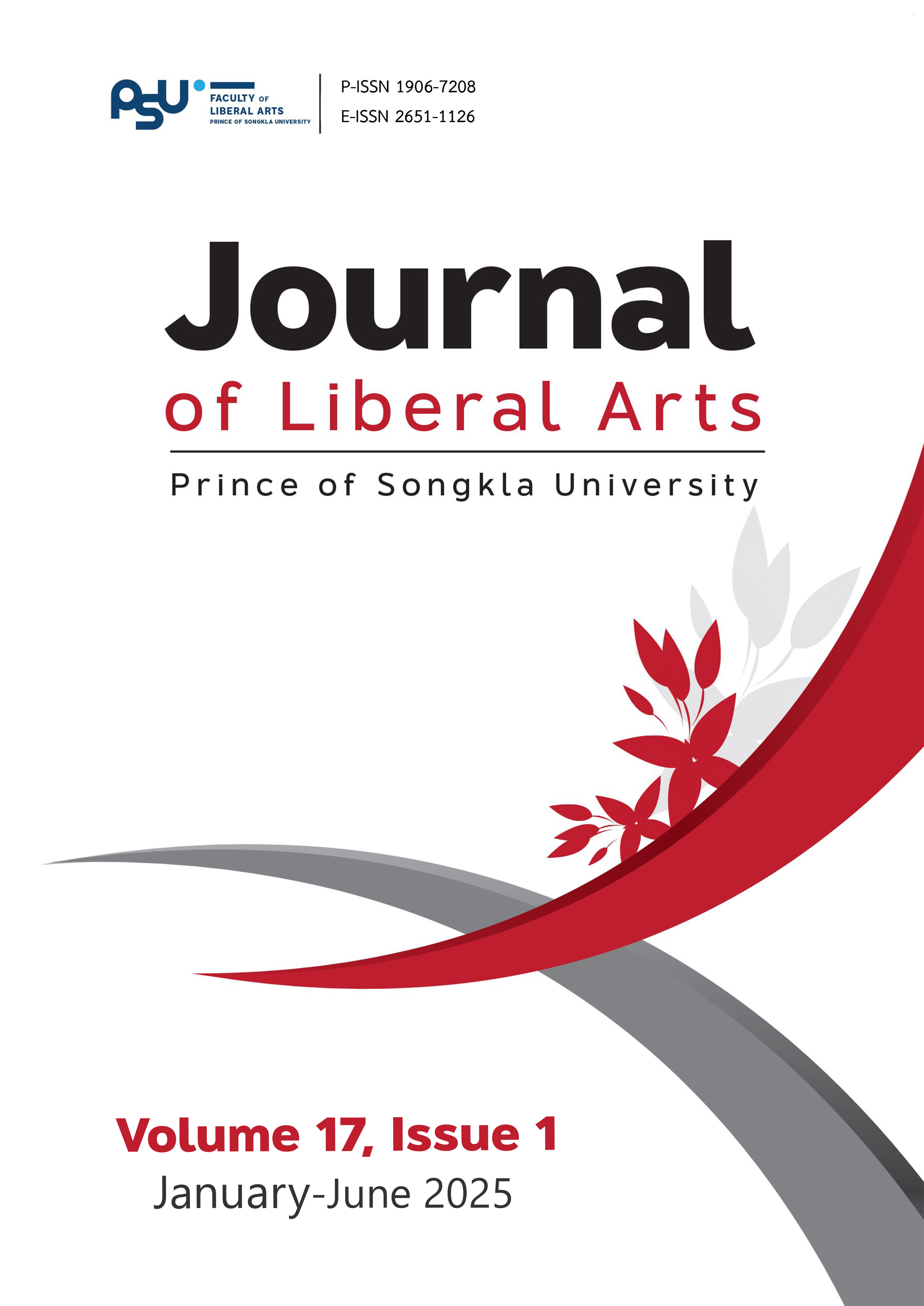Error Investigation of Public Signs and Foreigners’ Perceptions of Business Signs in Bangkok: A Case Study of Sathorn and Sukhumvit Areas
DOI:
https://doi.org/10.14456/jlapsu.2025.1Keywords:
Linguistic Landscape, Linguistic Landscape in Thailand, Language Policy, Intelligibility on Signs, Grammatical ErrorsAbstract
Although news reports reveal grammatically incorrect signs in Thailand, many studies have overlooked the impact of these errors. Mistakes on public signs could confuse foreigners and reflect negatively on the nation’s language proficiency. Addressing these errors is essential, as they affect readers’ comprehension and the country’s image. These errors should be investigated for grammatical mistakes that impact foreigners’ understanding of English-language signs. The study began with a questionnaire distributed to 30 foreigners to understand their viewpoints on error signs, focusing on 40 signs with grammatical errors. The findings highlighted two main points. Firstly, 17% of the total error signs received low scores in the survey. The English on these public signs was unclear and grammatically incorrect, making it difficult for foreigners to understand. Secondly, error signs involved selection (30%) and omission (28%) strategies based on Corder’s (1973) theory. Errors such as inappropriate vocabulary, misspellings, and word omissions led to unintelligibility. This study is critical for stakeholders, including travelers in the Sathorn and Sukhumvit areas, as well as governmental and non-governmental organizations, as it aims to improve and produce effective public signs. The recommendation of the study includes replacing governmental and non-governmental signs with linguistically accurate and appropriate versions. Ultimately, this will benefit our country by boosting investor confidence, promoting a positive national image, and attracting more tourists.
References
Abisamra, N. (2003). An analysis of errors in Arabic speakers’ English writings. Retrieved November 26, 2024, from https://abisamra03.tripod.com/nada/languageacq-erroranalysis.htm
Ariani, N. M., & Artawa, K. (2022). Analysis of the grammatical errors of English public signs translations in Ubud, Bali, Indonesia. Journal of Language and Linguistic Studies, 18(2), 809-909. https://www.jlls.org/index.php/jlls/article/view/2974
Backhaus, P. (2007). A comparative study of urban multilingualism in Tokyo. International Journal of Multilingualism, 3(1), 52-66. http://doi.org/10.21832/9781853599484
Bangkokpost. (2021, November). English gets raw deal. Bangkokpost. Retrieved February 9, 2024, from https://www.bangkokpost.com/opinion/opinion/2219235/english-gets-raw-deal
Chaudary, F., & Moya, M. (2019). An examination and analysis of a learner’s errors from the perspective of a pedagogical grammar [Proceedings Conference]. Applied Linguistics and Language Teaching Conference Proceedings. https://repository.uel.ac.uk/item/8452v
Corder, S., P., M. (1973). Introducing applied linguistics (n.d.). Penguin.
Derwing, T. M., & Munro, M., J. (2015). Pronunciation fundamentals. John Benjamins Publishing Company. https://doi.org/10.1075/lllt.42
Guo, M. (2012). Analysis on the English-translation errors of public signs. Academy Publisher, 2(6), 1214-1219. https://doi.org/10.4304/tpls.2.6.
Huebner, T. (2006). Bangkok’s linguistic landscapes: Environmental print, code mixing and language change. International Journal of Multilingualism, 3(1), 31-51. https://doi.org/10.1080/14790710608668384
Kachru, Y., & Smith, L., E. (2008). Cultures, contexts, and world Englishes. World Englishes, 28(1), 136-138. https://doi.org/10.1111/j.1467-971X.2008.01574_3.x
Landry, R., & Bourhis, R., Y. (1997). Linguistic landscape and ethnolinguistic vitality. Journal of Language and Social Psychology, 16(1), 23-49. https://doi.org/10.1177/0261927x970161002
Netthanyakonwong, A. (2023). The error analysis of Chinese translation of airport public signs in Thailand. Journal of Studies in the field of Humanities, 31(1), 147-169. https://so04.tci-thaijo.org/index.php/abc/article/view/261623
Ngampramuan, W. (2019). Intelligibility of English on signs in tourist attractions in Thailand. ASIA journal, 12(1), 95-121. http://www.asiajournal.ru.ac.th/pdfjs/web/viewer.html?file=http://www.asiajournal.ru.ac.th/journals/1580367435_a4.pdf
Park, K., J., & Nakano, M. (2003). Interlanguage and its role in English education: in cross-cultural distance learning and language acquisition (n.d.). Hankook Publishing Company.
Rhekhalilit, K. (n.d.). Unit 1 intelligibility [Paper presentation]. The English and Globalization course, Kasetsart University, Thailand.
Smalley, W., A. (1994). Linguistic diversity and national unity: Language ecology in Thailand (n.d.). University of Chicago Press.
Thaipost. (2022, November). Kho a phai phitphlat “ko tho pho” chaeng kae khai pai APEC 2022 sakot phit laeo. (in Thai) [EXAT Apologizes for Mispelled APEC 2022 Sign]. Thaipost. Retrieved February 9, 2024, from https://www.thaipost.net/general-news/263245/
Thairath. (2017, March). Rong sue pai bok sathan thong thiao ‘doi phatang-wiangkaen’ khian phit won hai kae. (in Thai) [Locals Appeal Media as Their 'Doi Phatung - Wiangkaen' Tourist Sites Signs Mispelled]. Thairath. Retrieved February 9, 2024, from https://www.thairath.co.th/news/local/873321
Thairath. (2017, September). Chao wiang kaen rong sue pai bok thang khian phit klua khon sap son khwam mai plian. (in Thai) [Wiangkaen Residents Plead Media as Their Direction Signs Baffles]. Thairath. Retrieved February 9, 2024, from https://www.thairath.co.th/news/local/north/1059430
Talbot, D. (2023, December). How many people speak English. Wordsrated. Retrieved February 9, 2024, from https://wordsrated.com/how-many-people-speak-english
Wang, Y., H. (2022, December). Low English proficiency in Thailand could hinder the country’s development prospects. Thailand Business News. Retrieved February 22, 2024, from https://www.thailand-business-news.com/business/94596-low-english-proficiency-in-thailand-could-hinder-the-countrys-development-prospects
Downloads
Published
How to Cite
Issue
Section
License
Copyright (c) 2025 Siraprapa Kongkaew, Siriporn Lerdpaisalwong

This work is licensed under a Creative Commons Attribution-NonCommercial-NoDerivatives 4.0 International License.
The authors retain the copyright to their article but the Journal of Liberal Arts, Prince of Songkla University reserves the exclusive rights to first publication.






